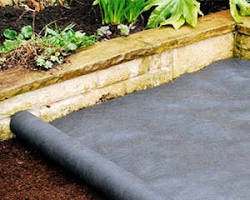Geotextiles are a type of geosynthetic material that is made from synthetic or natural fibers. They have a wide range of applications, including landscaping. Geotextiles can be used for a variety of purposes in the garden, including:
- Drainage: Geotextiles can be used to improve drainage in the garden. They can help water flow more easily, which can prevent flooding and erosion.
- Soil improvement: Geotextiles can be used to improve poor soil. They can help hold soil in place and prevent it from being eroded by wind or water.
- Weed control: Geotextiles can be used to control weeds in the garden. They can help prevent weeds from growing by blocking sunlight and oxygen.
- Creating vertical gardens: Geotextiles can be used to create vertical gardens. They can help hold media in place and prevent it from falling.
Geotextiles are available in a variety of types, including woven geotextiles and non-woven geotextiles. Woven geotextiles are made from synthetic fibers that are woven together in a regular pattern, while non-woven geotextiles are made from synthetic fibers that are randomly arranged.

Non-woven geotextiles are more commonly used for landscaping because they have several advantages, including:
- Durability: Non-woven geotextiles can last for many years.
- Weather resistance: Non-woven geotextiles are resistant to UV rays, water, and extreme temperatures.
- Weed resistance: Non-woven geotextiles can help prevent weeds from growing.
When choosing geotextiles for landscaping, it is important to consider your specific needs. Factors to consider include:
- Soil type: Different geotextiles perform differently in different soil types.
- Particle size: Geotextiles with smaller particle sizes are more effective for weed control.
- Thickness: Thicker geotextiles are more durable.
Here are some examples of how geotextiles can be used for landscaping:
- Drainage: Geotextiles can be used to improve drainage in the garden by placing them under the soil layer. They will help water flow more easily, which can prevent flooding and erosion.
- Soil improvement: Geotextiles can be used to improve poor soil by placing them over the soil layer. They will help hold soil in place and prevent it from being eroded by wind or water.
- Weed control: Geotextiles can be used to control weeds in the garden by placing them under the media layer. They will help prevent weeds from growing by blocking sunlight and oxygen.
- Creating vertical gardens: Geotextiles can be used to create vertical gardens by placing them inside pots or planters. They will help hold media in place and prevent it from falling.
Geotextiles are a versatile material that can be used for a variety of purposes in the garden. They can help improve drainage, improve soil, control weeds, and create vertical gardens.


No comments yet